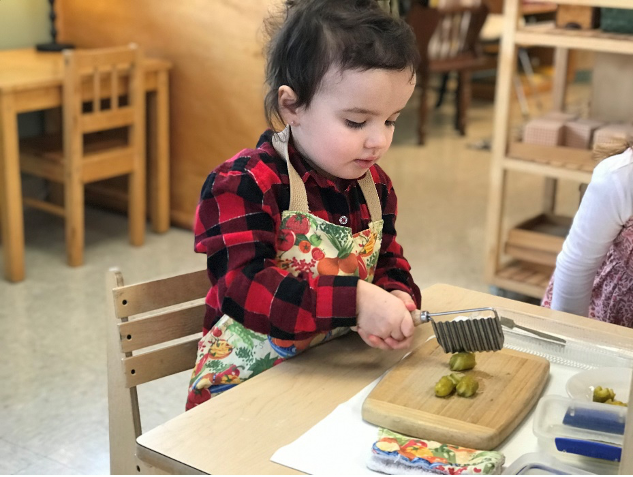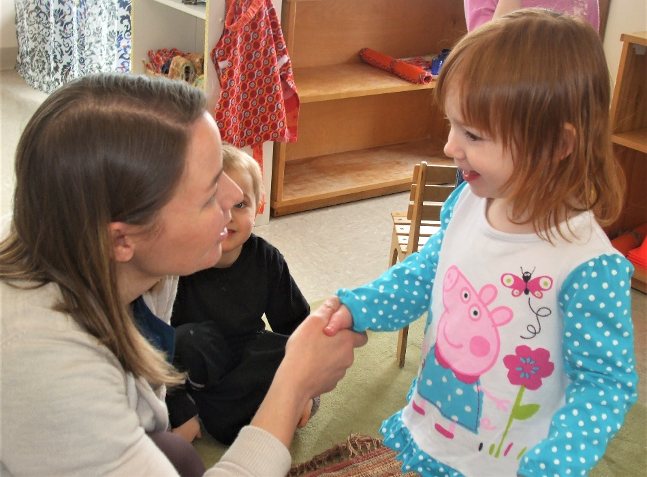What is ‘Practical Life’?
Montessori Basics: What is ‘Practical Life’?
As Montessorians we believe education is more than just academics. We aim to nurture not only the intellect, but the development of the whole child in an effort to prepare them for all aspects of life.
Practical Life in Montessori begins early; you will find these activities intentionally woven into both toddler and primary classrooms, and beyond. The activities themselves are intended to give children practice so that they may work toward being independent in everyday living. Read on to get an understanding of what this looks like in the classroom, and what parents might do to continue this important work at home.
Care of the Environment
Children are not only capable of caring for their environment; they enjoy the process, especially when they are very young. In Montessori classrooms children are given lesson on how to clean up spills, care for pets and plants, wash dishes, fold napkins, and clean tables. Each of these lessons is given slowly and methodically, with the adult modeling the correct way to complete each activity. Children are given tools that are sized to work for them, and these tools are placed within reach of the child so that they may access them independently.
This work can be easily continued at home. Take the time to model household activities for your child, keeping in mind you will likely need to model the same activity multiple times before they feel confident on their own. There are a variety of child-sized tools available for purchase, but those are not necessary to accomplish the goal. For example, if you would like to teach your child how to clean floors, Montessori Services has a perfect child sized wet/dry mop or keep it simple and use a rag and a spray bottle. Small dustpan and brush sets are easy to find, too, and will be used for years to come. Designate a small corner of your home to store these items. A small bin or basket is helpful, or low hooks on the wall.
By teaching children how to care for their environment, they gain confidence and independence in their ability to function as a contributing member of the family (or classroom!).
Control of Movement
In most Montessori primary classrooms observers will find a elliptical line taped on the floor. This is intentionally placed as an opportunity for the students to hone their gross motor skills. Children are presented by the Guide to walk slowly and with purpose, keeping their feet on the line and balancing as they go. Sometimes the addition of a bell can add challenge to the activity, with a child walking carefully so as not to allow the bell to ring as they move. More practiced students might walk on the line while balancing something on their head!
Similar activities can be done almost anywhere at home. Children naturally gravitate toward walking and balancing on logs, curbs, or anything else they come across. The challenge for many of us as adults can be to notice the importance of this activity in the moment, to slow down, and to allow for the child to immerse themselves in the experience. While it’s not always possible to stop and do this, your child will feel immense pride and accomplishment if they have the opportunity to slow down and just practice balancing.
Montessori environments provide lots of fine motor experiences for children. In the classrooms, there are opportunities for pouring (rice, beans, water, etc.), transferring things from one container to another, and using a variety of implements to do so. Wondering how this might look at home? Try letting your child help out in the kitchen. There is no shortage of scooping, measuring, and using of tools that require concentration and fine motor development. All of this fine motor Practical Life is perfect preparation for writing.
Care of the Self
One excellent marker of independence is how well we are able to care for ourselves. In Montessori schools children are taught from an early age how to do simple things, such as put on and remove their shoes and coat by themselves. Children are expected to do this daily and they take great pride in doing so. At home parents can start by allowing children to choose their own clothing (within weather-appropriate parameters) and to dress themselves. Clothing can be kept on low shelves and in low drawers so that the child may access it easily. Allow extra time for your child to make their best effort with this essential skill.
One fun element of this area of practical life is food preparation. Children are given lessons on how to prepare a simple snack. This might include chopping of fruits and vegetables, spreading things like hummus or cream cheese, stirring ingredients together, or any other number of simple skills. All needed materials and food supplies are set up as individual activities. Once a child has been presented how to do a food activity, for example slicing bananas, the activity is available to access throughout the day so a child can make a snack for themselves. (This does not replace the morning snack that is provided for all children.) Food preparation is a fun and natural activity to do at home and can be a wonderful bonding activity in the family.
Grace and Courtesy
Grace and Courtesy refer to how we model for the children to be respectful and polite to others. Much of this work centers on adults using appropriate vocabulary and movements associated with being polite and courteous in our society. We teach children to say “please”, “thank you”, “you’re welcome”, and “excuse me”. We encourage them to hold doors for each other, to offer food to one another, and to check in with anyone who is feeling hurt or upset.
Grace and Courtesy are also about helping children develop empathy. We are social beings who need to live together peacefully if we are to accomplish anything. Maria Montessori believed that children are the key to peace among humanity. This important work begins with simple practical life lessons, and continues throughout childhood and beyond.





